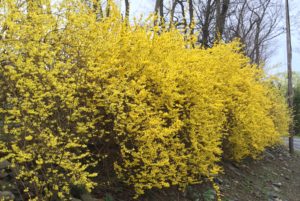Hello Fellow Readers,
Forsythia is one of the first shrubs to bloom, announcing spring has arrived! I love the sunny yellow welcome to the bland dormant landscape. It’s true after the early yellow wake-up call, they can turn into unwieldy shrubs, inspiring folks to prune them into unnatural shapes or hedges. Especially as the golden glory grows, overhead folks tend to prune the lower parts creating a shrub with a mohawk haircut. There’s a certain someone around here named Curt who tends to do such a thing. Rather than the familiar Forsythia x intermedia, which grows 8 to 10 feet tall and 10 to 12 feet wide, you can plant smaller cultivars such as ‘Golden Peep,’ ‘Goldilocks,’ and ‘Gold Tide’ that stay 4 feet or less. There are white and pink varieties, Abeliophyllum distichum and A. ‘Roseum’, that also stay 4 to 5 feet. That way, there’s no need for bad haircuts.
Forsythia spreads readily, which is why I never recommend using them close to the house. They are beautiful and practical as screening from neighbors on more significant properties. The flexible stems weep to the ground and root themselves, which is called propagation by layering. You can help this process along in early spring by bending the tip of a branch with new growth and covering part of it with soil. Once rooted, which may take one or more growing seasons, you can separate it from the mother plant and transplant it elsewhere.
Peggy of Hope NJ asked why her forsythia aren’t blooming. Forsythia needs about six hours of sunlight to bloom. Most often, however, it’s caused by improper pruning as they bloom on year-old wood. Maybe you have a stealth pruner at home too? Or maybe deer are taking nibbles even though forsythia is ranked “seldom severely damaged,” according to Rutgers University’s deer resistant list.
It could be the old canes are suffocating the newer ones and not allowing air to circulate. Prune out the older branches from the plant’s base to maintain the graceful shape of the shrub. As with any flowering woody plant, it’s best to prune soon after the bloom cycle. Never use hedge clippers to sheer the ends of forsythia as the plant will remain dense with old wood in its core, suffocating new branching and inhibiting bloom. There, there Curt.
If your forsythia is way out of control and driving you batty, you can rejuvenate them in early spring by cutting them almost to the ground. (Close your ears, my love). Of course, you’ll miss the sunny yellow flowers this year.
Garden Dilemmas? Askmarystone@gmail.com
Earth-friendly tips:
While forsythia is in bloom, it’s time to spread organic corn gluten – an environmentally friendly option for weed control rather than chemical pre-emergent.
Too much nitrogen can thwart bud production. So, if you are spreading lawn fertilizers high in nitrogen (please don’t), adding phosphorus such as bone meal should help counteract the nitrogen overload around your forsythia.
Forsythia branches are easy to force to bloom inside in January through February. Cut stems and place them in water for a sunny winter boost in about ten days. Left long enough in the water, don’t be surprised if roots develop, giving you babies to plant out in the yard.



